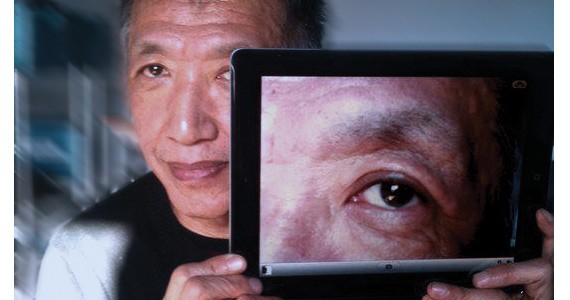We're in room 207 at the Chelsea Hotel with two men wearing nothing but their tight white briefs and socks. The thinner man, who sports a buzzcut, is recalling his childhood crush on an older, glamorous Pakistani woman, while a fit young man, Jermain, sits on the bed cutting up crack rocks and half listening to his rambling monologue. "She was my Mrs. Robinson. I always imagined having a love affair with her when I was a child," reminisces the man with the buzzcut, who happens to be Attila Richard Lukacs, an artist best known for his paintings of fetishized skinheads, monkeys and American military cadets. Suddenly Attila's got a leash around his neck, which Jermain holds, while Attila paints a portrait on the carpet.
Soon one thing turns into another: Jermain's taken off his briefs, explaining under his breath that "this shit makes me feel open" and gauging from his blissed-out expression and heavy breathing, it seems like he's getting a blow job. But we don't know exactly what's happening or how we even got to this hotel room, because, like many of Vancouver-based multi-media artist Paul Wong's shorts, Chelsea Hotel Room 207 (2007) raises more questions than answers. This month, the Centre for Art Tapes and Saint Mary's University Art Gallery are presenting home-style, a selection of Wong's shorts (September 18-23, Saint Mary's University Art Gallery, artist talk on September 20, 8pm), as part of Halifax's Prismatic Festival, which exhibits new works by artists from diverse cultural backgrounds.
Wong's work runs the gamut from video installations to his "big glamorous spectacles," but for home-style, curator J.J. Kegan McFadden chose 10 shorts filmed on hand-held cameras. Viewers witness everything from punks in East Vancouver torching a block of houses following their eviction to a beautiful girl named Sally in a luxurious bubble bath at Beijing's China Club. Though some of Wong's films might not seem out of place on YouTube, he exhibits his work in the art house film circuit, a space he seeks to both claim and subvert, causing viewers to question just what defines art today.
Born in British Colombia in the '50s, Wong describes his Vancouver upbringing as "very much immigrant class," spent working in family-owned cafes and grocery stores in a city where he always felt like an outsider, "a city that's full of gloss and glass and sparkle, but at the same time there's the everyday realities of those who are not part of going up the economic ladder." Wong's films capture the lives of people on the margins of society, and do so without looking for approval or sympathy, being didactic or overly embracing shock value. His films---often described as "anti-art"---are spontaneous, intuitive and unapologetically raw.
Wong's use of hand-held cameras lends his films an intimacy, rendering both the artist and the viewer complicit in the subjects' activities. The lines between artist and subject are blurred---Wong is often an active participant in his films, frequently popping up lounging in bathrobes and taking long puffs of his cigarette. On one chilly Sunday afternoon, Wong films himself trying to pick a song to do heroin and cocaine to in his apartment, an attempt to create "the perfect day." He rejects the notion that documentary filmmaking can be unbiased and objective, an idea that to him "has always been a crock of shit." Indeed, he can't seem to stay behind the lens: "That was a good puff," he says, filming Jermain smoking crack. "I got a little blast, that was perfect."

